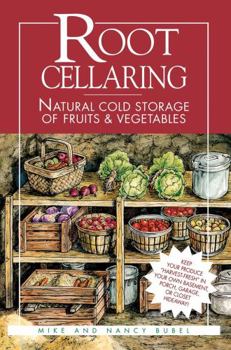Root Cellaring: Natural Cold Storage of Fruits & Vegetables
Select Format
Select Condition 
Book Overview
Anyone can learn to store fruits and vegetables safely and naturally with a cool, dark space (even a closet!) and the step-by-step advice in this book. This description may be from another edition of this product.
Format:Paperback
Language:English
ISBN:0882667033
ISBN13:9780882667034
Release Date:January 1991
Publisher:Storey Publishing
Length:320 Pages
Weight:1.16 lbs.
Dimensions:0.8" x 6.0" x 8.9"
Customer Reviews
4 ratings
A must have for the serious gardener
Published by Thriftbooks.com User , 19 years ago
If like me you love growing a vegetable garden and then canning, freezing, or dehydrating your produce, then this is a book you should seriously consider adding to your library. Especially since energy costs for cooling in summer and heating in winter are going up. Because root cellars are something as the one chapter in the book titled Food Cellars for Everyone says, are for everyone whether you live in rural American, suburbia or even a city with a small lot. Roots cellars are economical across the board and have a long history and can be placed under a home, off into a hillside, in a closet, basement or even two big wine barrels with tight lids planted slanted into the ground. They are also a huge money saver. And being someone who believes that even a city dweller with a small plot of land should grow some of their own food I also believe that we all have a responsibility to learn how to grow food as well as save it, because with our recent history of hurricanes in the southern regions of the country I know that attic cellars have enabled friends I know, to at least have fresh vegetables to cook over the camp stove as they go about trying to get their lives back together.
Encyclopedia of no-energy food preservation
Published by Thriftbooks.com User , 20 years ago
This book is a vast resource of information about root cellars, how to build them, and how to use them. The Bubels contend that even city apartments dwellers can arrange some sort of cold food storage area with a little imagination and a few suggestions from those who have done it before. The book has 6 parts: choosing good storage vegetable varieties, harvesting for keeping quality, storing crops in the root cellar, root cellar ideas for those who don't currently have a root cellar, root cellaring experiences, and recipes. At the end of the book is a bibliography for further reading, a list of plant sources, and an index. The book is amply illustrated with diagrams and black-and-white photographs. I didn't expect to find much in this book that I haven't read elsewhere. Since my house didn't come with a root cellar, I wasn't very optimistic about finding anything in the book that I could use. Fortunately, I was way off-base in these assumptions. I was amazed at the variety and detail of information that the Bubels provide. The sections on choosing seed varieties and determining when to harvest are extremely useful, even if you're only going to put your harvest in the refrigerator. They also explain the different types of storage conditions required for different crops- -some like it cool and moist, and others warmer and dry. But what gave me real hope was all the ideas about un-root cellars that people have constructed and made good use of for storing vegetables. Their examples include everything from insolated window baskets for apartment dwellers to buried package trucks. One idea that might work well for my situation at least for the time being is a buried refrigerator. Down the line, if I have extra time on my hands, I could trade up for a real dug root cellar, following the plans in the book. If you're a gardener, you'll find something of use for sure in this book.
My Oh My!
Published by Thriftbooks.com User , 25 years ago
A must buy for country-wise, self sufficient individuals. I initially borrowed it from the library, but it's worth the expense. Stretch your garden further than ever with this in-depth gem of a book.
This book gives the complete root cellaring picture.
Published by Thriftbooks.com User , 25 years ago
We're fortunate to have bought a property with a well designed root cellar already in place. Until I read this book, I had no idea how a root cellar 'worked'. This book suggests what foods are best for root cellaring, how long to expect to store them, and what temperatures should be maintained. Had I not read this book I would have wasted time and enery, and lost the nutrients in some foods by canning them rather than root cellaring them. A city dweller friend of mine borrowed my book and has decided to buy it. There are variety of good root cellar plans complete with illustrations and drawings for nearly any situation.






